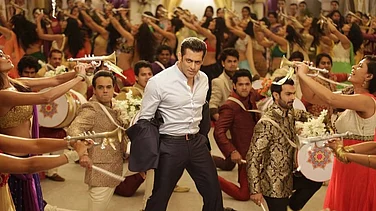In the early hours of 6 January 2021, long before Donald Trump’s supporters stormed the Capitol, and when the world was still reeling from the horrors of the Covid-19 pandemic, a strange silence washed over me as I stared at my laptop screen, transfixed by the work of artist Kirtika Kain. Here was a visceral image of vast blackness with hints of gold and red glinting from beneath its powerful surface. Swirls of a tar-like substance glowed on my screen, held together by what seemed to resemble clay and cracked soil. The work emanated a certain resilience for reasons unknown to me at the time. It also spoke volumes for its aesthetic potency and careful use of colour and material.
I wondered about the title of the work, Jina Amucha, recalling a book with the same title. Eager to know more, I emailed Kirtika, mentioning that I was pursuing a doctorate in Art History and would like to discuss this work in more detail for inclusion in my thesis. Not only did she very kindly reply to my initial request for more information but she also generously offered me glimpses into her life as an artist from the Dalit diaspora.
I mention my interaction with Kirtika to highlight the value and insight conversations with artists bring to art criticism and art writing. Through multiple exchanges, I learnt, for instance, that Jina Amucha was inspired by the seminal book with the same title (The Prisons We Broke in English translation) by Babytai Kamble, that speaks of the Mahars in the early 20th century. I discovered that Kirtika had created this piece over the early phase of the 2020 worldwide lockdown in her Sydney home, occasionally even in collaboration with her mother, who helped form a huge part of Kirtika’s understanding of her Dalit identity. I understood Kirtika’s careful curation of materials (beeswax, tar, charcoal, cow dung, religious thread and gold leaf to name a few) to be a redefining of these largely religiously charged materials on her own terms in the safe space that was her studio. I started to appreciate Kirtika’s narrative on the canvas as a visual rendition of a personal and collective inheritance; an untold story that was becoming a living archive. Most importantly, I realised that while her artwork partly spoke of a story of historical suffering, it also had elements of joy and power and was a celebration of her own Dalit identity and culture, a culture that Kirtika suggests ‘can exist outside of protest’.

My collaboration with Kirtika highlights the pedagogical role that art plays in society today. I use the word ‘collaboration’ here to insist on there being an alliance between the artist and the person writing about the artwork. A collaboration suggests an ongoing dialogue, and this remains a crucial part of writing about art, especially when writing about the work of living artists.A collaborative space also allows for opinions to form and grow. The pedagogy that I cited is in relation to this collaboration. When viewing pieces like Jina Amucha, viewers are often left wondering about the implications of the artwork. ‘‘But what does this mean?’’ is a common chorus that echoes in spaces where art is displayed. Indeed, what does a work like Jina Amucha connote?
In my first viewing of it on my laptop in early 2021, was it simply the aesthetic power of the work that captured my attention, or did I imagine there was more to the story and that a work of art must have a narrative in order for us to appreciate its aesthetic prowess even further? Circumstances point to the latter, for I immediately reached out to Kirtika, insisting on acquiring more context, not satisfied with just looking at the art and accepting it in its swirl of blackness. Kirtika’s subsequent narrative and my interpretation of it as viewed in her art underlies our collaboration, and illuminates a learning on my part as art historian. This learning is crucial in the context of artists like Kirtika who talk about caste in their art; it becomes foundational in understanding the genealogies of caste narratives and in highlighting my own ‘protected ignorance’ (as Y.S. Alone terms it). This is not to say that it becomes the artist’s role to educate the larger public about histories of oppression. Rather, I am trying to highlight the power of the visual and the flexibility in its interpretation as being instrumental in changing attitudes, forming opinions and presenting caste as a heterogeneous expression of personal and collective histories and ongoing circumstances.

My own learning from speaking with artists like Kirtika; Sajan Mani who shared thoughts on performativity, animality and caste; Prabhakar Kamble who showed how a horrific incident like the flogging of Dalits at Una could be reflected in performance art; G. Chandru and Savi Sawarkar—older artists who spoke about caste in the mainstream art world long before caste was openly addressed; Rajyashri Goody who shared the delights of eating and Dalit food recipes; Siddhesh Gautam who curated the digital space to revolutionise art expressions in relation to caste; Jaisingh Nageswaran who captured honest photographs of varying narratives; and reading scholars such as Y.S. Alone, Anjali Arondekar, Gary Tartakov, Deeptha Achar, Santhosh Sadanandan and Brahma Prakash Singh has been invaluable. The artists have generously shared their narratives with me, emphasising my earlier reference to collaboration.

The artists I mention here are just a small fraction of the large number who broach caste in their work. I only refer to these artists since I have had direct communication with them. Also, in turn, the scholars’ writings have helped shape my thoughts on categories like Dalit art, caste-life narratives, performativity and theatre, and the idea of mazaa or joy in expressions of caste. My aim here is to offer reflections of my own interactions with artists and scholars; emphasise the pedagogical and collaborative role that I found to be inspiring in my learning about art, art practice and artists’ lives; and the contexts in which these are placed. Aesthetic choices remain pertinent to the art that is finally produced. Deeptha Achar calls the aesthetic in relation to the category of Dalit art ‘a site of political challenge’—art then seems to be placed in a paradox, where it holds a unique position of highlighting centuries of oppression while also wanting to be appreciated just in terms of its beauty and aesthetics. Does the art exist only to draw attention to the social and the political, or can it exist outside of protest, be removed from a socio-political context, and be treasured for its powerful use of materiality like in Jina Amucha?
The visual power of art is colossal. Art’s magic memorialises stories, aesthetics and individuals. It leaves me asking questions in a way that non-visual learning renders impossible. In places like India where Dalits face discrimination in dehumanising ways on a daily basis, romantic notions of art as a site of resistance perhaps seem misplaced. But a push towards dialogue in art history, where value is given to being in conversation with living artists is crucial in contemporary society. The role art plays in society as a tool of survival, understanding and pedagogy must be acknowledged. I have learnt through art, and it is in this learning that I have seen power, joy, history and beauty unfold as visual vocabulary for time immemorial.
(This article is drawn from my doctoral research at the University of Edinburgh.)
(This appeared in the print as 'A Canvas Of Exchanges')
Anisha Palat is a PHD candidate in history of art, University of Edinburgh





















